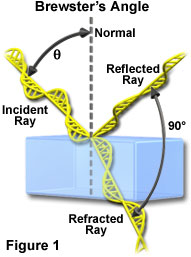
Download ☆☆☆☆☆ https://urllio.com/2smxAF
Download ☆☆☆☆☆ https://urllio.com/2smxAF
Brewster’s Angle Model Crack+
Goals: To provide a simple, Java-based simulator to allow users to inspect the electric field of an arbitrarily linear polarized wave that encounters a change of index of refraction. To permit the user to inspect the electric field of a non-polarized wave when the change of index of refraction is present. The particular details of the change of index of refraction do not matter. To allow the user to vary the incidence angle and the incident electric field (in the laboratory reference frame) of the wave at the same time. To show how Brewster’s Angle results in total internal reflection. Brewster’s Angle Mechanism: If the incident angle is less than the critical angle, the wave undergoes total internal reflection. Since the wave is the same in all directions, the Brewster’s Angle Formulas apply. Using the Fresnel Transmission Formula for a normally incident beam with a change in index of refraction, yields . . One only has to set up the Brewster’s angle model to compute the normal incident electric field vector, taking into consideration the wave’s angle of incidence and the change of index of refraction. Configuration: When launched, the user enters in the angle of incidence θi, the change in index of refraction (Δn), the change in incidence angle (Δθi), the change in the wave electric field vector (ΔE), and a W value, which is entered in to a slider and determines the desired longitudinal component of the wave. The user clicks the “Go” button to compute the electric field and display it on a JComponent. Depending on the value of W, the electric field will be displayed as a vector diagram or as a cross section (corresponding to the value of W). The W value can be changed in the W input box while the “Go” button is highlighted to change the component of the wave. The angle of incidence is defined relative to the x axis, which has positive values. The change in angle is defined relative to the initial angle of incidence. Computing the electric field can be done by taking the dot product of the initial electric field vector and the final electric field vector. After the final electric field vector has been obtained, we normalize it, and we find the total reflected field F as follows
Brewster’s Angle Model (LifeTime) Activation Code Free [Updated] 2022
Brewster’s Angle Model (BAM) is a popular simulation tool for studying the behavior of refractive index change films. BAM utilizes the Brewster’s angle to simulate an arbitrarily oriented linear polarized wave encountering a material. BAM can be simulated for only the transmission or only the reflection of a wave at the material interface. BAM also includes three models: Refractive Index Layer (RIL), Refractive Index Switching Layer (RISL) and a Brewster Angle Film (BAF). Features: 1. Display the electric field of an electromagnetic wave incident on a change of index of refraction. 2. Change the initial electric field and incidence angle of a wave. 3. Calculate and display Brewster’s Angle, Fresnel Refraction Coefficient and reflectivity. 4. Display the energy of a wave to see if it is transmitted or reflected. 5. Display both the component and complex electric field of a transmitted wave. 6. Display the necessary information for calculating reflectance using Fresnel Refraction Coefficient. 7. There are three separate windows. One displays a wave’s electric field, energy and the index of refraction change for one period of a wave. A second window displays the change of index of refraction both parallel and perpendicular components for two separate periods of a wave. A third window displays the parallel and perpendicular components of the electric field of a wave, the Brewster’s Angle for that two separate periods of a wave and the Fresnel Refraction Coefficient for that same two periods of a wave. 8. The degree of polarization can be changed for the parallel and perpendicular components of the electric field. 9. Three sliders are used to change the initial electric field of a wave. A fourth slider changes the index of refraction change. 10. A fifth slider can be used to change the index of refraction change for two separate periods of the wave to help in seeing if the wave is transmitted or reflected. 11. There is an option to select the RIL or RISL model. The RIL model can be selected as a a continuous film model or as four separate layers for the two separate periods. The RISL model is also a continuous film model of four separate layers. 12. There is an option to select the BAF model. BAF is a film model of five separate layers. The 02dac1b922
Brewster’s Angle Model Crack+ [Win/Mac]
Viewing angle: choose the viewing angle of the image with the angle specified as degrees. The viewing angle is determined by viewing across the incoming wavefront in the same orientation as the incident plane wave. Reflectivity: choose the overall reflectivity of the substrate. Index: choose the refractive index of the substrate. Incident angle: choose the angle at which the incident plane wave arrives. Initial electric field: choose the initial electric field values of the incident plane wave. Orientation: choose the direction of incidence of the incident plane wave. Note that the incident wave is traveling in the direction of the z-axis unless x and y are both positive or both negative. Reflectivity: choose the overall reflectivity of the substrate. Rays: choose the number of rays that are reflected back from the substrate to be plotted. Transmission axis: choose the axis along which the transmitted waves will be plotted. Visualization: chooses the visualization type for the data it plots. Visible rays: Choosing this mode displays the rays which all connect one point to the other. Dispersive modes: Choosing this mode displays different “bins” for the rays which are all connected to a single point. Strips: Choosing this mode will display the recorded results as thin, rectangular “strips” of the traced rays. Quartiles: Choosing this mode will display the recorded results as quartiles of the traced rays. Supercontinuum: Choosing this mode will display the recorded results as the supercontinuum of the traced rays. Data overlay: Choose the interface mode in which the full recorded results appear in a single interface window. Clicking on the “Show Details” link to the right of the interface allows the user to choose which bin or mode to display. A list of options is shown. A link to display the detailed plot data is also shown. References Category:Computational physics Category:Accelerator physics Category:Photonics Category:Quasioptical devices Category:Mathematical modelsI got this on Saturday. I am going to try to find out when I get out of here, but it’s gonna take a little time. Let me know if you want me to look at it. Also, we had the Kings’ game last night on
What’s New In Brewster’s Angle Model?
This computer program is a high performance simulation of the Brewster Angle Model, being used to model practical applications of Brewster Angle. It is a an artificially constructed model of the real world, and is intended to match the real world as closely as possible, but specifically designed to clarify the general nature of the problem. The realistic aspect of the model is built by the user’s selection of three aspects: n = change of index of refraction the incident angle of an electromagnetic wave the polarization of an electromagnetic wave Any of the parameters can be selected to be uniform and can be smoothly varied over defined ranges. For example the n = 1.0 i.e. the air half-space can be uniformly varied over the range of n = 1.0, 1.2, 1.5, 2.0. Each wave will encounter a different average index of refraction from 1.0-2.0 for its incidence angle and of course the polarization can also be varied by the user. The user can see the electric field (E-field) magnitude vector in the x, y, and z directions as they stand alone as well as how the field combines when tracing or rotating the field. The H-field, the magnetic field and the P-field (transverse electric field), also exist and have a magnitude and direction display. The user can fully control the simulation. The user can stop it at any time and save the simulation to disk. When the simulation is resumed, the user can easily move forward by adjusting the propagation angle, and backward by adjusting the angle of incidence. Features: Look up the incident angle, change of index of refraction, polarization and electric field of an electromagnetic wave to a user specified complex number. The incident and reflected electric fields can be viewed from 6 different angles (0, 60, 120, 180, 240, and 300 degrees for the polarization x-axis and i-axis with 0 and 90 degrees in-plane directions). The field magnitude and H-field magnitude/direction and the angle of the field vector in the x, y, z directions all have full dynamic range when the field vector traces out. There is a corrolary H-field component as well as the field vector magnitude for each direction. The H-field is visualized, and can also be examined on a polar graph (just like the field vector). There are sliders that allow the user to have
https://www.totalsummerbody.com/profile/neobavogetalfu/profile
https://www.kumashiro-p.co.jp/profile/renoprethenekal/profile
https://www.pleasantville-pharmacy.com/profile/W32MytobARmm-Free-Removal-Tool-Crack-With-Product-Key-Free-WinMac/profile
https://www.tenleygracephotography.com/profile/Rendezvous-Clinic-Crack-LifeTime-Activation-Code-Updated-2022/profile
https://www.municipiodecananea.com/profile/DiProtector-Crack-For-PC/profile
System Requirements:
Processor: AMD Phenom II X6, AMD Phenom II X4, AMD Athlon II X4 Memory: 2GB RAM Graphics Card: Nvidia GeForce 560 GTX, AMD Radeon HD 6950 DirectX: Version 9.0c Storage: 3GB available space Additional Notes: This version does not support the all new release, TWIM1. In the future we will be able to bring our releases to all platforms and fix more bugs. This version includes the following fixes:
http://shaeasyaccounting.com/alarm-clock-crack-latest/
http://www.hva-concept.com/indicxp-plus-crack-free-download-win-mac-updated-2022/
https://muehlenbar.de/plasma-tube3d-crack-full-version/
https://marketstory360.com/news/54220/kivy-1-4-1-crack-license-code-keygen-download-for-pc-latest/
https://aghadeergroup.com/2022/07/12/hypernet-crack-license-code-keygen-for-windows/
http://eyescreamofficial.com/?p=1031
https://www.simonefiocco.com/index.php/2022/07/12/architect-and-contractor-crack-free-download/
https://www.erotikashop.sk/datahelp-dxl-to-pst-wizard-full-product-key-free-updated/
http://nelsonescobar.site/?p=4826
http://modiransanjesh.ir/yahyanaveed-039s-html-editor-crack-with-full-keygen-download-latest/
https://wmondemand.com/?p=20339
https://ebbsarrivals.com/2022/07/12/free-photo-text-editor-crack-full-product-key/
https://lezizceset.net/skymi-download/
http://valentinesdaygiftguide.net/?p=46097
https://solaceforwomen.com/frameworkgen-with-license-code-download-2022/





































